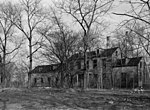Chapel of the Good Shepherd (Roosevelt Island)
1888 establishments in New York (state)19th-century Episcopal church buildingsChurches completed in 1888Churches in ManhattanChurches on the National Register of Historic Places in New York (state) ... and 7 more
Episcopal church buildings in New York CityManhattan Registered Historic Place stubsManhattan church stubsNew York City Designated Landmarks in ManhattanProperties of religious function on the National Register of Historic Places in ManhattanRoosevelt IslandUnited States Anglican church stubs

The Chapel of the Good Shepherd is a historic Episcopal church designed by architect Frederick Clarke Withers and built in 1888, located at 543 Main Street on Roosevelt Island in Manhattan, New York, United States. It was originally an Episcopal chapel, but is now the Good Shepherd Community Ecumenical Center, used for Episcopal worship services and by other groups.The chapel was listed on the National Register of Historic Places in 1972, and was restored in 2003.
Excerpt from the Wikipedia article Chapel of the Good Shepherd (Roosevelt Island) (License: CC BY-SA 3.0, Authors, Images).Chapel of the Good Shepherd (Roosevelt Island)
Main Street, New York Manhattan
Geographical coordinates (GPS) Address Website External links Nearby Places Show on map
Geographical coordinates (GPS)
| Latitude | Longitude |
|---|---|
| N 40.761769444444 ° | E -73.950555555556 ° |
Address
Church of the Good Shepherd
Main Street 543
10044 New York, Manhattan
New York, United States
Open on Google Maps







